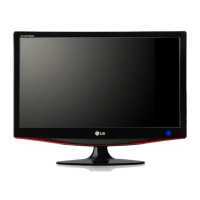
Do you have a question about the LG M227WAP and is the answer not in the manual?
| Screen Size | 22 inches |
|---|---|
| Resolution | 1680 x 1050 |
| Aspect Ratio | 16:10 |
| Panel Type | TN |
| Brightness | 300 cd/m² |
| Contrast Ratio | 1000:1 |
| Dynamic Contrast Ratio | 50000:1 |
| Response Time | 5 ms |
| Viewing Angle (Horizontal) | 170° |
| Viewing Angle (Vertical) | 160° |
| Power Consumption (Standby) | 1 W |
| Input Ports | DVI-D |
Describes controls on the side of the monitor TV.
Details the controls located on the front panel of the monitor.
Illustrates and identifies the connectors on the back panel.
Step-by-step guide for assembling and attaching the monitor stand.
Instructions on how to remove the monitor stand.
Steps for removing the stand body from specific monitor models.
Guidelines for mounting the monitor horizontally on a wall.
Instructions for placing the monitor on a desktop stand.
Guidance on adjusting the monitor's tilt and swivel for optimal viewing.
Recommendations for placing the monitor in a suitable environment.
Instructions for securing the monitor to a wall to prevent tipping.
Method for securing the monitor to a desk to prevent falls.
Information on using the Kensington security slot.
How to connect an antenna for TV signals.
Guide for connecting an HD receiver using component cables.
Steps for connecting a set-top box via HDMI.
Instructions for connecting a DVD player using component cables.
How to connect a DVD player using an HDMI cable.
Guide for connecting a VCR using RF or RCA cables.
Connects various audio/video devices like camcorders or game sets.
How to connect and use the monitor as a PC display.
Visual guide for managing cables behind the monitor.
Lists compatible resolutions for PC and HDMI input.
Explains the functions of the remote control buttons for TV operation.
Steps for powering on the monitor from standby mode.
How to change TV channels using the remote or buttons.
Instructions for adjusting the audio volume level.
Guide to navigating and adjusting settings via the on-screen display.
Process for automatically scanning and storing TV channels.
Method for manually tuning and arranging TV channels.
Adjusting reception for optimal picture and sound quality.
How to assign custom names to TV channels.
Options to delete, move, or skip stored TV programmes.
How to set and select favourite TV channels for quick access.
Displaying and navigating the list of stored TV programmes.
Adjusting the display format (e.g., 16:9, 4:3) for optimal viewing.
Selecting predefined picture modes like Vivid, Standard, Cinema, sRGB.
Fine-tuning picture settings like brightness, contrast, and sharpness.
Advanced settings for enhancing picture quality (e.g., contrast, colour).
Restoring picture settings to their original factory defaults.
Adjusting picture position and stability for PC input.
Manually adjusting screen position, phase, clock, and H/V for PC input.
Resetting all menu options to factory default values.
Matching monitor resolution to PC output for optimal display.
Selecting preferred sound profiles like Standard, Music, or Cinema.
Customizing sound settings such as Treble and Bass.
Automatically maintains a consistent volume level across channels.
Adjusting the sound balance between the left and right speakers.
Restoring sound settings to their original factory defaults.
Selecting mono, stereo, or dual language sound output.
Choosing sound output for left and right speakers in various modes.
Setting the current time and date for timer functions.
Programming the monitor to turn on or off automatically.
Setting the monitor to automatically turn off after a specified time.
Automatic power-off when no input signal is detected.
Choosing the display language for the on-screen menus.
Enabling a feature to prevent unauthorized operation via remote control.
Enabling PC communication for detailed setup via PC.
Controlling the LED indicator light for power status.
Selecting between Home Use and Store Demo modes.
Resetting all monitor settings and programmes to factory defaults.
Turning the teletext service on and off.
Basic teletext page selection and colour button programming.
Using colour-coded buttons for faster teletext page selection.
Explains functions like TIME, SIZE, UPDATE, REVEAL, INDEX, HOLD, MIX.
Solutions for common problems with the monitor's operation.
Guidelines for cleaning the screen and cabinet, plus extended absence precautions.
Detailed technical specifications for the M197WAP model.